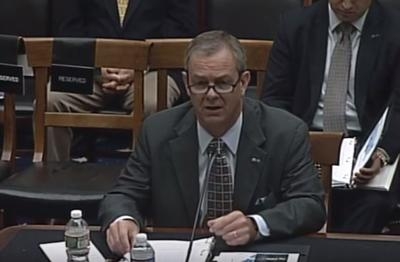Says States May Create 'Questionable' Laws That Will Tie Up Courts, Cost Taxpayers
In recent testimony before a House subcommittee, AUVSI President and CEO Brian Wynne said the FAA needs to complete the small UAS rule and assert its authority over the National Airspace System to avoid a “legal quagmire” as states move to ban or limit unmanned aircraft use.

“While my industry supports the safe, non-intrusive use of UAS technology, we’re concerned about creating inconsistencies with federal law,” Wynne (pictured) told members of the House Energy and Commerce Committee’s Subcommittee on Commerce, Manufacturing and Trade. “Only the FAA can regulate airspace, states and municipalities cannot.”
He said in the absence of FAA action, states may create “questionable” laws that will tie up the courts and cost taxpayer money.
“It is critical for the federal government to assert its preemption authority over the National Airspace System,” Wynne said. “As more commercial UAS operators are certified, they will join the long-standing aviation community, which I have been part of for the last 20 years as an instrument-rated general aviation pilot,” Wynne said. “They will foster the aviation community’s principles of airmanship and self-policing to promote safety and thwart careless and reckless operations.”
Asked during the question period if the FAA has mapped out an adequate roadmap for UAS integration, Wynne said yes, but with a caveat.
“We know what the work is that needs to be done, I don’t think it’s properly funded today,” Wynne said.
He said the FAA’s new UAS Center of Excellence, and the existing test sites, can help prove out some of the technology that is required for full integration, including sense and avoid technology.
“The FAA has to direct that, and in some instances they need to be able to fund some of that, of course with appropriate industry resources as well,” he said.
Joshua M. Walden, senior vice president and general manager of Intel’s New Technology Group, demonstrated one way his company is contributing to that culture of safety, specifically by focusing on sense and avoid capability for small UAS.
Intel has developed what it calls the RealSense depth-sensing camera, a module that weighs only eight grams and is less than four millimeters thick, but gives a drone 360-degree awareness of what’s around it.

Walden demonstrated the system by flying a small prototype drone in the committee hearing. During a voting recess, he further showcased the RealSense technology, as witnesses approaching the hovering UAS and tried to touch it, only to watch it move away from them.
“Intel has visited with [FAA] Administrator Huerta and FAA officials on a number of occasions to explain how Intel RealSense can enhance drone safety technology, and are pleased to assist in the ongoing efforts to reduce the near-miss rate of drones down to zero,” Walden said.
He echoed comments made by Wynne, who pointed out the numerous industries seeking to use unmanned aircraft, and said “society, consumers, business and the overall worldwide economy stand to benefit in profound ways if the nascent drone ecosystem can develop safely, quickly and in a manner where governments and the private sector work cooperatively and expeditiously across a range of statutory, regulatory and policy matters.”
Margot Kaminski, of Ohio has been participating in the National Telecommunications Infrastructure Agency’s efforts to establish best practices for drone uses regarding privacy.
She said she cautions the federal government against enacting legislation governing information-gathering by drones used by private operators.
“Courts will need time to unravel the tension between state drone privacy laws and countervailing First Amendment interests,” she said. “In the meantime, federal energy can better be turned toward the data privacy issues that drones and other new technologies raise.”
(Source: AUVSI news release. Images from file)
 ANN's Daily Aero-Term (12.19.25): Ultrahigh Frequency (UHF)
ANN's Daily Aero-Term (12.19.25): Ultrahigh Frequency (UHF) NTSB Prelim: Cirrus Design Corp SR22T
NTSB Prelim: Cirrus Design Corp SR22T Classic Aero-TV: The Red Tail Project--Carrying the Torch of the Tuskegee Airmen
Classic Aero-TV: The Red Tail Project--Carrying the Torch of the Tuskegee Airmen Aero-News: Quote of the Day (12.19.25)
Aero-News: Quote of the Day (12.19.25) Airborne 12.17.25: Skydiver Hooks Tail, Cooper Rotax Mount, NTSB v NDAA
Airborne 12.17.25: Skydiver Hooks Tail, Cooper Rotax Mount, NTSB v NDAA




